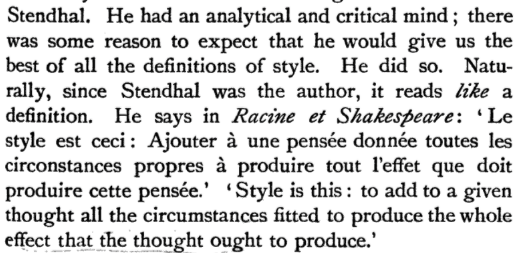|
Spring 2023, Rhetorics of Style
Professor: Drew Kopp (WA 01350 - 1; crn 24635) Mon/Wed 2:00 -- 3:15 Victoria 201 Office Hours: by appointment |
Note: Taking this course will fulfill the Elements of Language requirement for the Writing Arts major. |
Course DescriptionRhetorics of Style introduces students to the theory and practice of writing with stylistic devices and strategies. Through studying, analyzing, experimenting and writing with a range of stylistic devices, students will develop a practical understanding of how to put figural language to use for persuasive, expository, and aesthetic ends, as well as develop an appreciation for the ethical implications of stylistic choices.
OverviewIn this course students will practice identifying stylistic choices, work to understand how style functions in context, and perform a range of stylistic maneuvers within a variety of writing situations. Students will learn to write with the force associated with the figural use of language--language that turns away from common everyday usage. Students will also learn to appreciate the ethical consequences of stylistic choices made to achieve a variety of ends, whether aesthetic, persuasive, or expository.
Key to these aims is to identify the figural register in writing, wherein we focus on words and sentences and what they do, rather than what they indicate, or point to. In his Handlist of Rhetorical Terms, Richard Lanham claims that the figures of rhetoric testify “to a kind of verbal attention which looks at the verbal surface rather than through it,” and so tropes and schemes have “worked historically to teach a way of seeing” (79). Furthermore, as Rutgers (Camden) scholar William FitzGerald argues in “Stylistic Sandcastles” (2013), when we place style centrally, “the goals attendant to rhetorical education through style-focused pedagogies are most fully achievable” (47). Consequently, central to this course is style. When we work to master figures of speech and thought, which include what are called tropes and schemes, we become empowered to think, write, and create in ways that reflect what it means to be rhetorically educated, that is, we discover for ourselves what it means to be receptive to differences beyond the familiar, and to be empowered to adapt and respond appropriately to such differences with a growing repertoire of rhetorical maneuvers, such as those maneuvers we will work to master in this course. |
|
Course Activities
|
Students will:
|
Required Texts
Forsyth, Mark. The Elements of Eloquence: Secrets of the Perfect Turn of Phrase. Berkeley, 2014.
Harris, Robert A. Writing with Clarity and Style: A Guide to Rhetorical Devices for Contemporary Writers. 2nd Edition. New York: Routledge, 2018.
Harris, Robert A. Writing with Clarity and Style: A Guide to Rhetorical Devices for Contemporary Writers. 2nd Edition. New York: Routledge, 2018.
Style adds to a thought all the circumstances needed to produce the whole effect which that thought ought to produce. --Stendhal |
From John Middleton Murray's The Problem of Style 79

